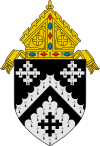St. Elizabeth of Hungary Shrine (Cleveland, Ohio)
St. Elizabeth's Magyar Roman Catholic Church | |
 Front, seen from east | |
| Location | 9016 Buckeye Rd., Cleveland, Ohio |
|---|---|
| Coordinates | 41°29′7″N 81°37′24″W / 41.48528°N 81.62333°W |
| Area | Less than 1 acre (0.40 ha) |
| Built | 1918 |
| Architect | Emile M. Uhlrich |
| Architectural style | Italian Baroque |
| NRHP reference No. | 76001402[1] |
| Added to NRHP | January 30, 1976 |
St. Elizabeth of Hungary Catholic Church is a historic Roman Catholic church in the Buckeye Road neighborhood on the east side of Cleveland, Ohio, United States. The earliest ethnic parish established for Hungarians in the United States, its present building was constructed in the early twentieth century, and it has been named a historic site.
Parish history

Cleveland's first Hungarian Catholics initially worshipped at St. Ladislaus' Church, an east-side Slovakian parish, but ethnic strife and increasing immigration prompted the Hungarian community to seek their own parish. Bishop Horstmann interceded on their behalf with papal authorities, and Charles Boehm of Hungary settled in Cleveland in late 1892 to serve the new St. Elizabeth parish, the first Hungarian nationality parish in America. Boehm immediately began registering members and advocating for the construction of a church complex; the first church building, a brick structure, was erected by the end of 1893, a school soon followed, and a larger school was completed in 1900 because of expanded enrollment. He also began a Hungarian-language parish newspaper that soon gained subscribers in other parts of the United States and in Hungary. Julius Szepessy took Boehm's place in 1907 after the latter left to begin missions among Hungarians in America, but after Szepessy died in 1923, Boehm returned and remained until retiring in 1927.[2]
The parish was weakened in 1904 as Hungarian Catholics living in western Cleveland began to weary of their three-hour round trip for Mass. With Boehm's support, the new St. Emeric's Church was created for them; it was the first of more than a dozen Hungarian parishes established directly or indirectly through his influence. Nevertheless, Boehm's remaining parishioners were numerous enough that the old building was insufficient for their needs, and by the time of his departure in 1907, he had begun to raise money for the erection of a replacement. Before his death, Szepessy saw the completion of the present structure, along with a parish hall that became a community center for the neighborhood's Hungarians.[2]
Architecture
St. Elizabeth's first building with a basic Gothic Revival structure of brick, completed in 1893 and removed in 1917 for the construction of the present building. Although the cornerstone was laid in 1918,[3] the construction process was lengthy, and it was finally completed only in 1922.[2] Built primarily of limestone,[1] according to a design of Cleveland architect Emile Uhlrich, the church is an example of Italian-influenced Baroque Revival architecture, partly modelled after the church of Sant'Agnese in Agone in Rome.[3] Two great towers, topped with cupolas, form the ends of the facade, while a great rose window sits in the middle section of the facade high above the main entrance. A flight of steps rises from the sidewalk to the central main entrance, which sits along the sidewalk with no setback.[4]
Preservation
In 1976, St. Elizabeth's Church was listed on the National Register of Historic Places, qualifying both because of its place in the area's history and because of its historically significant architecture.[1] The building has been well maintained, due partially to funds from generous bequests, but membership has fallen significantly from the parish's height. Most of the neighborhood's Hungarian residents left in the 1970s, due largely to disappearing factory jobs and rapidly rising crime rates. However, comparable weakening at the west side daughter parish, St. Emeric's, and another Hungarian parish in Orange, St. Margaret's, prompted Bishop Lennon to close those two parishes in early 2009 and urge their members to begin worshipping at St. Elizabeth's.[5]
References
- ^ a b c "National Register Information System". National Register of Historic Places. National Park Service. July 9, 2010.
- ^ a b c Papp, Susan M. Hungarian Americans and Their Communities of Cleveland. Cleveland: Cleveland State University, 1981.
- ^ a b Owen, Lorrie K., ed. Dictionary of Ohio Historic Places. Vol. 1. St. Clair Shores: Somerset, 1999, 271-272.
- ^ St. Elizabeth's Magyar Roman Catholic Church, Ohio Historical Society, 2007. Accessed 2010-02-13.
- ^ Smith, Robert L. "St. Elizabeth of Hungary Could Be Center of Movement to Revive a Hungarian Neighborhood at Buckeye Road", The Plain Dealer, 2009-07-23. Accessed 2014-11-30.
- Roman Catholic churches completed in 1918
- 20th-century Roman Catholic church buildings in the United States
- Baroque Revival architecture in the United States
- Buckeye-Shaker
- Churches in Cleveland
- Churches in the Roman Catholic Diocese of Cleveland
- Hungarian-American culture in Cleveland
- Limestone churches in the United States
- National Register of Historic Places in Cleveland, Ohio
- Roman Catholic churches on the National Register of Historic Places in Ohio




